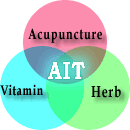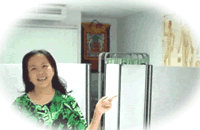Spondylopathy
( Spinal Degeneration )
In
a study group, 8 cases of lumbar spondylopathy, including spondylolisthesis,
spondylosis and osteoporosis, were treated by Acupoint Injection Therapy
(AIT) -- Chinese herbs and Vitamins injected directly into acupuncture
points (Huatuojiaji and back-shu points) from the first to the fifth
lumbar vertebrae. Another 6 cases of lumbar spondylopathy were treated
by conventional acupuncture as the controls. The results showed that
treatment by AIT at the Huatuojiaji points and back-shu points was superior
in analgesic effect and total clinical effective rate as compared to
conventional acupuncture. In this study group, an additional 3 cases
showed significant improvement from X-rays after three months (about
90 treatments). However, in the control group, not one case showed a
significant change in the X-rays.
CLINICAL
DATA
Among the 14 cases in this series, 7 cases were male and 7 female ranging
in age from 45 to 61 years old, with an average age of 53 years. The
shortest duration of illness was 2 years, and the longest 11 years.
The patients were divided into two groups (patients chose which treatment
they wanted by themselves) according to the present pain intensity (PP).
8 cases were in the treatment group (AIT). 6 cases were in the control
group (conventional acupuncture alone). There was no significant difference
in age and duration of illness between the two groups. The patients
were suffering from prolapse of lumbar intervertebral disc, lumbar muscular
fibrositis, lumbar muscle strain, spondylolisthesis, spondylosis and
generalized osteoporosis. Patients whose lumbago was due to kidney and
gynecological disease, and those who could not stick to the treatment,
were excluded.
DIAGNOSTIC
CRITERIA
1. Pain in the unilateral or bilateral lumbar region radiating to the
posteriolateral part of the leg above the knee joint level in severe
cases, but not exacerbated by increased the abdominal pressure.
2. Unable to sit and stand for long, with pain exacerbated after tiredness
and alleviated after rest.
3. X-rays show degenerative changes and tension, or spasm of the muscle.
4. On palpation, there is a tubercular or cord-like mass.
5. Erythrocyte sedimentation rate, antistreptolysin O test, and rheumatoid
factors are normal.
METHOD
OF TREATMENT
For the AIT treatment group, bilateral Huatuojiaji points (Extra) and
back-shu points (BL22, 23, 24, 25) from the first to fifth lumbar vertebrae,
we took turns in selecting the main points and the tenderness points.
Leg, hand, and even abdominal points were selected as the auxiliary
points. Specific Chinese herbs (such as Dang Gui, Xia Tien Wu, Yia Mu
Guar, etc.) & Vitamins (such as Vitamin B1, B12 , Bco, and Vitamin
C ) were injected by hypodermic syringe into case-specific points.
For
the control group, the acupuncture needles were inserted perpendicularly
into the same points. After insertion, the needles were slowly twirled
till the needling sensation transmitted towards the lumbar transverse
process. Needles were perpendicularly inserted into points to a depth
of 0.5-l.0 cun. The adjunct points were also stimulated in different
ways in different groups.
The
treatment was given once daily, 10 sessions constituting one course
of treatment, with a 1-day interval between courses -- 30 sessions with
3 days off for 3 months.
CRITERIA
FOR THERAPEUTIC EFFECT
The McGill Pain Questionnaire (MPQ) was adopted for comprehensive evaluation.
COMPLETELY CURED:
All clinical symptoms and signs disappeared. The functional movement
became normal and/or the X-rays improved to 100%.
MARKEDLY EFFECTIVE:
All clinical symptoms and signs basically disappeared, regaining normal
functional movement, and/or the X-rays improved significantly.
EFFECTIVE:
Clinical symptoms were alleviated, with improved functional improvement
and unchanged signs.
INEFFECTIVE:
No obvious improvement.
THERAPEUTIC
RESULTS:
Comparison of the analgesic effects between the two groups (see Table1):
Table 1. A comparison of the Difference in Pain Integration Before and
After Treatment Between the Two Groups:
| Index
|
Treatment
group(n=8) |
Control
group(n=6) |
| Positive
item number in selection of words |
2.53
+/- 0.72** |
1.42
+/- 0.24 |
| Sensory
score of pain rating index |
3.09
+/- 0.97** |
1.74
+/- 0.68 |
| Emotional
score of pain rating index |
1.25
+/- 0.23 |
1.39
+/- 0.31 |
| Total
score of pain rating index |
5.45
+/- 1.55* |
4.24
+/- 1.41 |
| Visual
analogue score (cm |
3.76
+/- 1.00** |
2.31
+/- 0.61 |
| Present
Pain intensity |
1.72
+/- 0.41** |
0.02
+/- 0.03 |
*
P<0.05, ** P<0.0l, compared with the control group
As
shown in Table 1, the differences in every index, except the emotional
score of pain rating index, between the treatment and control groups,
were significant or very significant (P<0.05 or P<0.0l), indicating
that AIT at the Huatuojiaji or back-shu points was superior in analgesic
effect to the control group.
A
comparison of the therapeutic effects in treatment of the third lumbar
transverse process syndrome between the two groups is listed in Table
2.
Table
2. Comparison of Therapeutic Effects between the Two Groups
| Group |
Cured |
Markedly
effective |
Effective |
Ineffective
|
Total
effective rate |
| Treatment
group(n=8) |
5
(62.5%) |
2
(25.0%) |
1
(12.5%) |
0
|
100% |
| Control
group(n=6) |
3(50.0%) |
1(16.7%) |
1(16.7%)
|
1(16.7%) |
83.4% |
Comparison
of the total effective rate between the two groups, x 2=5.3, P<0.05
As shown in Table 2, the total effective rate in the treatment group
was significantly higher than in the control group.
DISCUSSION:
This kind of spinal problem comes from the chronic retrograde in the
joint cartilage and the degenerative strain in the surrounding soft
tissues, which results in irritating symptoms by pressing on the nerve
root and blood vessels. This is due to a lack of sufficient blood circulation
to supply nutrition to the spine and soft tissue, which causes spondylopathy,
such as spondylolisthesis, spondylosis , osteoporosis, and other degenerative
changes.
Transverse processes of the lumbar vertebra are the most vulnerable
when the muscles and fasciae connected with the transverse processes
are pulled, contracted suddenly, or have abnormal loading. This may
lead to laceration, hemorrhage, and hematoma on the area connecting
the muscles with the transverse processes, which is followed by muscular
tension and spasm, and stimulation or compression of the lateral branch
of the posterior rams of the spinal nerve, thus resulting in pain in
the region of the transverse processes, buttock, and thigh. The lumbar
transverse process syndrome is a common disease in patients with lumbago
or lumbocrural pain. Its pathogenesis is related to the anatomical and
physiological characteristics of the lumbar vertebra, which is in the
middle of the physiological lordosis of the lumbar vertebrae, serving
as an axis of movement of the lumbar region. Therefore, the traction
stress borne by both of its transverse processes is the strongest among
the lumbar vertebrae. In addition, the transverse processes of the lumbar
vertebra are the longest among all the transverse processes of the lumbar
vertebrae. The lever effect on the transverse processes of the lumbar
vertebra is the strongest. Pulling forces borne by the ligaments, muscles,
fasciae, and aponeuroses adhered to the transverse processes are the
strongest as well.
Physiotherapy, or even conventional acupuncture produces poor therapeutic
results and needs long term treatment to prevent from getting worse.
It is very difficult to see any regenerative changes. We use AIT with
certain Chinese herbs and Vitamins to raise the effective rate.
1. Acupuncture points on the back (Huatuojiaji points and Back -shu
points), especially the points located in the affected area were selected
as the main acupoints, while the Ashi point and points on the leg, hand,
and even abdominal area were the auxiliary points.
2. A small dose of Chinese herbs and Vitamins performed the stimulating
role instead of acupuncture needles. Some points were injected with
Chinese herbs, such as Radix Angelica Sinensis, Radix Salviae Mitrorrhizae,
while other points were injected with Vitamins, such as Vitamin B1,
B12, and C.
3. The purpose of AIT is to primarily stimulate the back points to produce
the strong analgesic effects in a safe way. Secondly, AIT improves the
micro-circulation in the diseased area by promoting nutrition and oxygen
to that area and strengthening the muscles and surrounding soft tissue
to support the spine.
All of these factors contribute to the satisfactory results.
In our clinical practice, some patients with the syndrome were treated
by AIT alone, with a small dosage of Chinese herbs and Vitamins at the
Huatuojiaji points. Satisfactory effects were also obtained with a rapid
analgesic effect, which showed that stimulation of the trunk of the
posterior ramus of the spinal nerve positively contributed to nonspecific
lumbago. However, there was an obvious pathologic change in the patients.
Accordingly, we selected the local Ashi tenderness points to enhance
the therapeutic effect. The present study showed that instant and satisfactory
therapeutic effects were features of this therapy, with both the principal
and secondary aspects of the disease treated simultaneously. It was
superior to conventional acupuncture alone.
Some studies found through clinical and anatomical research that mechanical
stimulation of the trunk of the posterior ramus of the lumbar nerve
was the most common cause of nonspecific lumbago. It was also found
that the lumbago could be relieved by freezing of the posterior ramus
of the spinal nerve. The superior clunial nerves come out of the intervertebral
foramens of the first, second, and third lumbar vertebrae, then pass
through transverse ligaments and bone interfibrous foramen, running
along the dorsal aspects of the first, second, and third lumbar transverse
processes and close to the periosteum. Then they go through the intertransverse
sulci and pierce the muscles originating from the transverse processes
to their dorsal parts. The superior clunial nerve is easily injured
where it passes the root segment of the lumbar transverse processes.
Other researchers have determined the pulling force borne by the posterior
ramus of the spinal nerves in a three-dimensional movement of the lumbar
vertebrae in a fresh corpse. It was found that the stress on its trunk
was the strongest, and the trunk was the most vulnerable. The pulling
force borne by one pair of the posterior ramus of the second lumbar
nerves was the strongest among five pairs of posterior ramus of the
lumbar nerves. Injury is probable where it passes the root segment of
the third lumbar transverse processes. These findings tally with the
fact that there is tenderness over the area of the third lumbar transverse
process in most of the patients with nonspecific lumbago. In the light
of these findings, it is possible that the lateral branches of the posterior
ramus of the second and third lumbar nerves pass the third lumbar transverse
processes. Thereby, pain in the region of the third lumbar transverse
processes may result if their trunks are stimulated. Therefore, we treated
the third lumbar transverse process syndrome with AIT, using a small
dose of Chinese herbs and Vitamins at the Huatuojiaji points from the
first to the fifth lumbar vertebra with satisfactory effects. This results
from the needling sensation radiating to the pain area and drugs (herbs
and Vitamins) to prolong the stimulating effects.
CONCLUSIONS:
The results of this Pilot Study indicate that Acupoint Injection Therapy
(AIT) is a safe and effective therapy for patients with degenerative
spondylopathy, and thus offers itself as a viable option for the kind
of patient who refuses conventional therapy (long-term oral pain killers
or an operation): especially for patients who have no response to or
who suffer the negative side effects from pain-killers or an operation.
However, further research is necessary to prove the effectiveness of
this treatment on a large scale. We suggest that AIT deserves further
evaluation in larger and longer clinical trials. We are prepared to
conduct further research to compare AIT with conventional therapy.
Have a look  Spinal
Degeneration(Spondylopathy) 1 ,
Spinal
Degeneration(Spondylopathy) 1 ,  Spondylopathy
2,
Spondylopathy
2,  Degenerative
Change and Compression Fracture of Lumbar spine
Degenerative
Change and Compression Fracture of Lumbar spine


